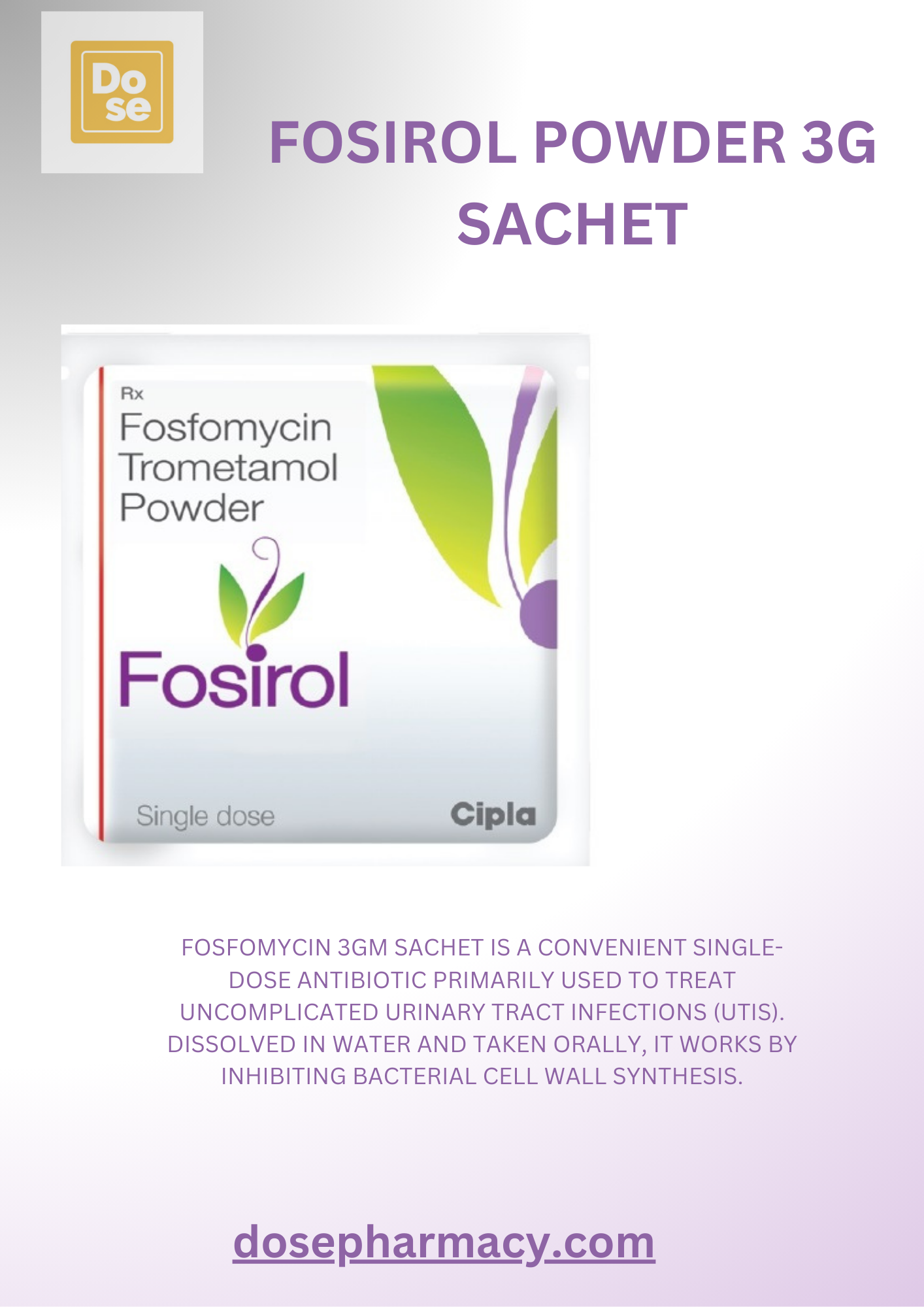
Urinary Tract Infections (UTIs) are among the most common bacterial infections, affecting millions globally every year. The discomfort and complications associated with UTIs often prompt swift treatment, and Fosfomycin uses has emerged as a reliable antibiotic in combating these infections. Known for its unique mechanism of action and effectiveness against resistant bacteria, Fosfomycin offers a promising solution in the realm of UTI treatment.
What is Fosfomycin?
Fosfomycin is a broad-spectrum antibiotic originally discovered in 1969. Derived from Streptomyces bacteria, it inhibits bacterial cell wall synthesis, effectively killing or inhibiting the growth of various gram-positive and gram-negative pathogens. Its unique mechanism of action allows it to bypass many common resistance mechanisms, making it a critical tool in the fight against multidrug-resistant bacteria.
Why Fosfomycin for UTIs?
Fosfomycin has gained prominence as a first-line treatment for uncomplicated UTIs, particularly those caused by Escherichia coli (E. coli), the most common culprit behind UTIs. Its ability to concentrate in the bladder and maintain therapeutic levels for an extended period makes it highly effective in treating urinary infections.
Key Benefits:
- Single-Dose Convenience: Fosfomycin is typically administered as a single-dose oral medication, simplifying treatment for patients.
- Broad-Spectrum Activity: It targets a wide range of pathogens, including multidrug-resistant strains like extended-spectrum beta-lactamase (ESBL)-producing bacteria.
- Minimal Resistance Development: Its unique action minimizes the risk of resistance when used appropriately.
How Fosfomycin Works
Fosfomycin acts by inhibiting the bacterial enzyme UDP-N-acetylglucosamine enolpyruvyl transferase (MurA). This enzyme is critical for peptidoglycan synthesis, a vital component of the bacterial cell wall. By disrupting this process, Fosfomycin weakens the bacterial cell, leading to its death.
Additionally, Fosfomycin’s ability to penetrate biofilms – protective layers formed by bacteria – allows it to combat infections where other antibiotics may fail.
Indications for Fosfomycin
While Fosfomycin is primarily known for treating UTIs, its applications extend to other infections:
- Uncomplicated Cystitis: A common bladder infection seen in women.
- Complicated UTIs: Involving anatomical abnormalities or resistant bacteria.
- Prophylaxis in Surgical Procedures: To prevent infection in urological surgeries.
- Multidrug-Resistant Infections: As part of combination therapy for resistant strains.
Dosage and Administration
For UTIs, Fosfomycin is usually prescribed as a single 3-gram oral dose dissolved in water. This regimen is sufficient for uncomplicated cystitis in women. However, for complicated UTIs or infections in men, additional doses or combination therapies may be necessary.
Patients should take Fosfomycin on an empty stomach, preferably before bedtime, to maximize absorption and therapeutic efficacy.
Effectiveness of Fosfomycin
Studies have consistently shown that Fosfomycin is highly effective in treating uncomplicated UTIs. Its efficacy rates are comparable to other first-line antibiotics like nitrofurantoin and trimethoprim-sulfamethoxazole.
Key Points Supporting Its Effectiveness:
- High Bladder Concentration: Fosfomycin achieves high concentrations in the bladder, directly targeting the site of infection.
- Long-Lasting Effect: Even a single dose can provide effective treatment, thanks to its prolonged urinary excretion.
- Reduced Resistance Risks: Its unique mechanism and broad-spectrum activity lower the chances of bacterial resistance.
Safety and Side Effects
Fosfomycin is generally well-tolerated, with minimal side effects. The most common adverse reactions include:
- Gastrointestinal Issues: Nausea, diarrhea, or abdominal pain.
- Headache
- Allergic Reactions: Rare, but may include rash or itching.
Severe side effects are rare but may include:
- Severe diarrhea due to Clostridioides difficile infection.
- Hypersensitivity reactions.
Who Should Avoid Fosfomycin?
Fosfomycin is not recommended for individuals with:
- Severe renal impairment (as it is excreted through the kidneys).
- Allergies to Fosfomycin or any of its components.
Fosfomycin vs. Other Antibiotics
When compared to other antibiotics, Fosfomycin offers several advantages:
- Single-Dose Therapy: Unlike antibiotics that require multiple daily doses, Fosfomycin’s single-dose regimen enhances compliance.
- Activity Against Resistant Strains: Its ability to treat multidrug-resistant pathogens gives it an edge in today’s era of rising antibiotic resistance.
- Fewer Drug Interactions: Fosfomycin has minimal interactions with other medications, making it suitable for patients on complex treatment regimens.
However, it may not be suitable for severe or systemic infections where intravenous antibiotics are required.
Emerging Concerns and Resistance
Although Fosfomycin has a low resistance profile, improper use can lead to resistance over time. Emerging reports of resistance in E. coli and Klebsiella pneumoniae underscore the importance of using this antibiotic judiciously. To preserve its efficacy:
- Avoid unnecessary prescriptions.
- Use it only for infections confirmed to be susceptible.
- Combine it with other antibiotics in severe cases.
Future Potential of Fosfomycin
Fosfomycin’s utility is expanding beyond UTIs. Ongoing research explores its role in treating infections like:
- Osteomyelitis (bone infections).
- Respiratory infections are caused by multidrug-resistant pathogens.
- Intra-abdominal infections.
Additionally, new formulations, such as intravenous Fosfomycin, are being developed to enhance its applications in hospital settings.
Practical Tips for Patients
If you are prescribed Fosfomycin for a UTI, here’s how to maximize its effectiveness:
- Take It Correctly: Dissolve the powder in water and consume it on an empty stomach.
- Complete the Dose: Do not skip or split the single dose.
- Stay Hydrated: Drink plenty of water to flush out the bacteria.
- Monitor Symptoms: If symptoms persist or worsen, consult your healthcare provider.
Conclusion
Fosfomycin stands out as an effective, convenient, and well-tolerated antibiotic for UTIs. Its ability to combat multidrug-resistant bacteria, coupled with its single-dose regimen, makes it a valuable tool in modern medicine. However, as with any antibiotic, responsible use is crucial to prevent resistance and ensure its long-term efficacy.
If you’re experiencing symptoms of a UTI, such as burning during urination, frequent urges to urinate, or lower abdominal pain, consult your healthcare provider. They can determine if Fosfomycin is the right choice for your treatment and guide you toward a swift recovery.